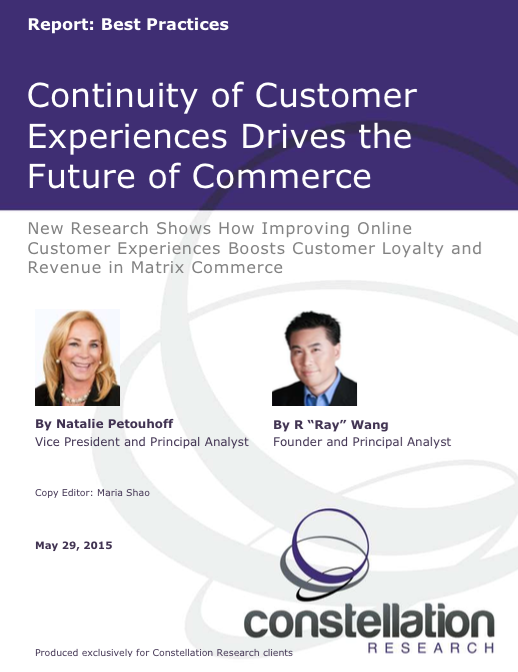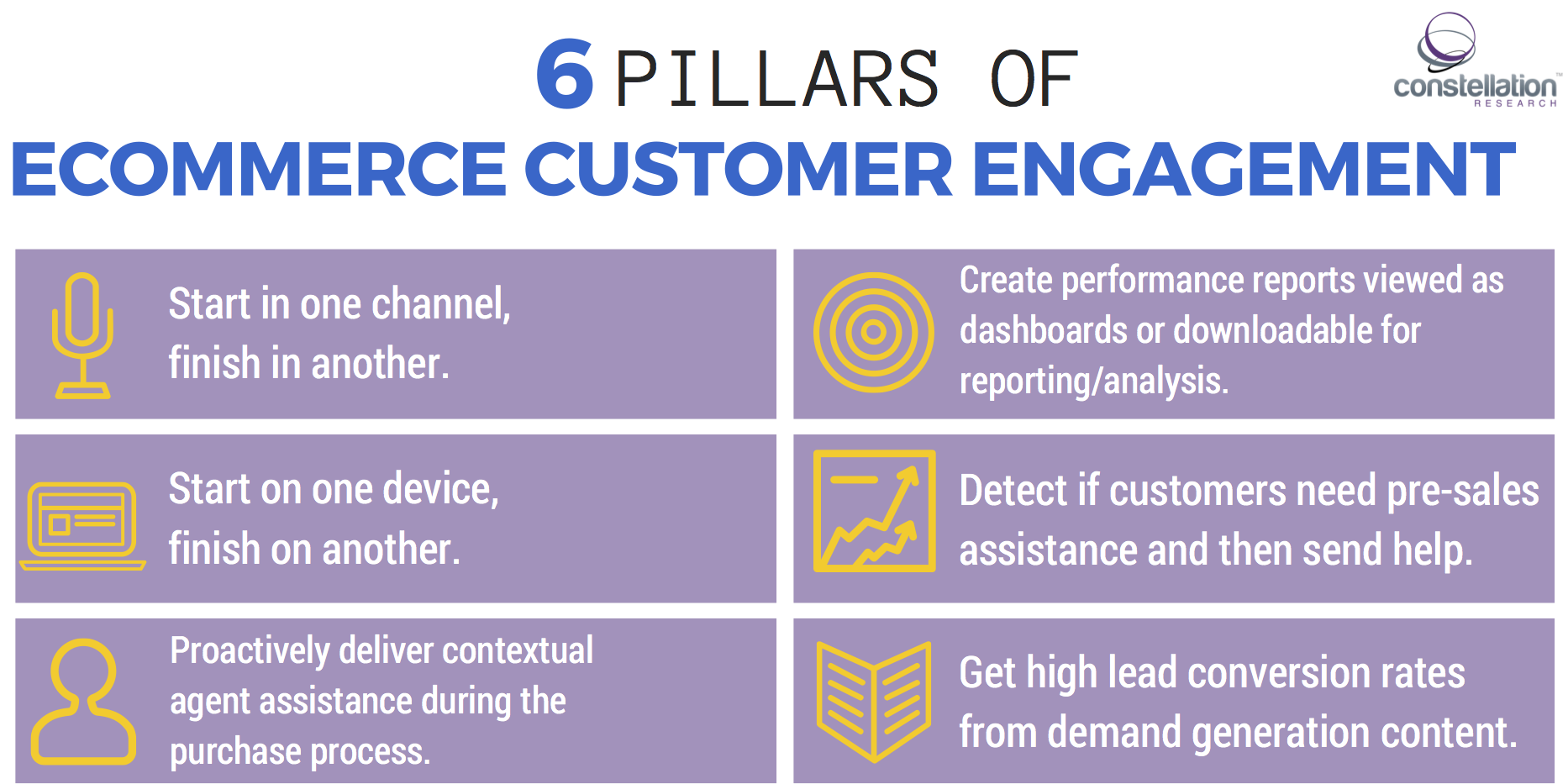 Continuity of Customer Experience Drives the Future of Commerce. I just finished some new research on how improving online customer experiences boosts customer loyalty and revenue in matrix commerce. This survey report provides online businesses with insights into e-commerce challenges, tools used for success, and plans for e-commerce usage in 2015-2020. The goal is to ensure better experiences and understand what experience-driven continuity means to online business leaders, learn how organizations rate their own brand’s online experiences today, discover what they do to engage with customers across devices, and find out how organizations would rate the emotional connection that customers have with their brand online.
Continuity of Customer Experience Drives the Future of Commerce. I just finished some new research on how improving online customer experiences boosts customer loyalty and revenue in matrix commerce. This survey report provides online businesses with insights into e-commerce challenges, tools used for success, and plans for e-commerce usage in 2015-2020. The goal is to ensure better experiences and understand what experience-driven continuity means to online business leaders, learn how organizations rate their own brand’s online experiences today, discover what they do to engage with customers across devices, and find out how organizations would rate the emotional connection that customers have with their brand online.
An excerpt of the report is available to download.
How End Users Should Use This Information: Clients should use this document as a best practices guide in developing online customer experiences that will positively drive revenue in matrix commerce initiatives. A successful customer experience on ecommerce consists of six elements I call the 6 Pillars of Customer Experience.

Start in one channel, finish in another.
- Stat: Only 29 percent of U.S. and 22 percent of U.K. brands reported that it was extremely easy for their customers to start the buying journey in one channel (e-mail, chat, video chat, mobile chat, co-browsing, etc.) and complete the purchase in another channel
- Customers expect to start the buying process in one channel and finish in another of their choosing.
- It is paramount to reach out to consumers at the moments that most influence their decisions.
- If a customer cannot easily transition from one channel to another in the buying process, a company will not be able to reach out to the customer at the moment the customer has questions, wants advice or needs help in making a decision.
- The customer journey must involve continuous interactivity and a two-way conversation with the brand at the right time, with continuity at its core.
Start on one device, finish on another.
- Stat: Only 35 percent of U.S. and 23 percent of U.K. brands reported that it was extremely easy for their customers to start the buying journey on one device and complete the purchase on another device and keep all the information for the order correct and complete.
- Customers expect to start the buying process on one device (desktop computer, tablet, smartphone) and finish on another.
- Leaders should make the business case for not only the technology to make it possible to start the buying process on one device and finish it on another, but also the staff and the training for them to help customers when they transition from one device to another.
Proactively deliver contextual agent assistance during the purchase process.
- Stat: Only 46 percent of U.S..and 48 percent of U.K..brands could provide excellent agent or human-assisted service through voice and chat while keeping intact the context about the customer’s search, previous purchases and likely purchases.
- Stat: In addition, only 49 percent of U.S. and 41 percent of U.K. brands could anticipate when a customer may need human assistance while on an e-commerce site.
- What this means is that brands are not able to provide the human touch often required to close a purchase or understand the context of customers’ potential purchases and help them make the best choice.
Create performance reports viewed as a dashboard or downloadable for reporting and analysis.
- Stat: Only 51 percent of U.S. and 34 percent of U.K. brands had technology that could provide a variety of e-commerce/website performance information as a dashboard.
- Without an easy way to look at analytics, the numbers can be lost on many people.
- Actionable insights must be provided in a dashboard fashion, with trends and easy-to-interpret “next best actions” in order to optimize e-commerce conversions.
- Stat: In addition, only 50 percent of U.S. and 34 percent of U.K. brands had technology that provided them with site performance reports that were downloadable for reporting and analysis.
- Without this capability, it is difficult to communicate to senior leadership about the trends, the progress or what is needed to convert more sales and drive higher profits.
Detect if customers need pre-purchase assistance and then support them and send help.
- Stat: Only 27 percent of U.S. brands and 19 percent of U.K. brands reported that it was extremely easy to send the customer help.
- When respondents were asked if they were able to detect when customers need pre-sales or pre-purchase support, the survey also asked them how they were able to determine the customer’s need.
- The breakdown of how respondents currently can determine (or not) whether customers need help indicate a very rudimentary approach.
- The way brands currently are able to determine if a customer needs pre-sales help is if there is general movement throughout the e-commerce site pages because they are toggling between products or because they are on a page for a long time.
- Brands need to be smarter than this and the right technology can help here.
- However, if the brand is not able to reach out to customers with the right information at the right time, it is unable to convert these in-need customers in time into purchasers.
- The various forms of assistance included being able to send a knowledge base article or offer a proactive, pre-sales chat designed to stop the customer from abandoning the site or the shopping cart.
Get high lead conversion rates from demand generation content.
- Stat: In order to secure the resources for content marketing to generate demand for products, brands need to be able to have a high lead rate for the content they create.
- This means that brands do not understand what type of content customers need to make up their minds and purchase the product. Content generation can be expensive and require additional staff.[2]
- Content is not something to be taken for granted. It takes budget, people, and process to deliver relevant content to engage customers and drive commerce.
Next Steps? Have you gotten your customer experience in shape so you can ultimately drive revenue and commerce? If so, what did you did you do? What do you think most brands are missing on this topic?
Download an excerpt of the report.
References
[1] Harris Poll Survey and Constellation Primary Research.



